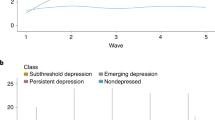Abstract
Despite considerable progress in the epidemiology of late life depressive disorders, the determinants and course of late life depressive symptoms remain unclear. The apparent reciprocal relationship between depression and disability, a consistent finding in cross-sectional studies further confounds efforts to estimate the importance of depressive symptoms in the elderly. In a longitudinal study of 1457 aged community residents who completed the Center for Epidemiologic Studies Depression scale at baseline and 24 months later, a significant level of depressive symptoms emerged in 163 respondents (11%), while 1080 (74%) remained symptom free. Unlike other studies, we found that the number of medical conditions, social support, life events, and demographic characteristics contributed little to distinguish those with emerging symptoms from those who remained symptom free. However, increasing disability and declining health preceded the emergence of depressive symptoms and accounted for seventy percent of the variance explained by discriminant analysis. These findings have etiologic implications for both the course and determinants of depression in late life.
Similar content being viewed by others
References
Aneshensel CA, Yokopenic PA: Tests for the comparability of a causal model of depression under two conditions of interviewing. J Personality and Social Psychology 49:1337–1348, 1985
Kinzie JD, Lewinsohn P, Maricle R, Teri L: The relationship of depression to medical illness in an older community population. Comprehensive Psychiatry 27:241–246, 1986
Kaplan GA, Roberts RE, Camacho TC, Coyne JC: Psychosocial predictors of depression: prospective evidence from the Human Population Laboratory studies. Am J Epidemiol 125:206–219, 1987
Lin N, Ensel WM: Depression-mobility and its social etiology: the role of life events and social support. J Health and Social Behavior 25:176–188, 1984
Phifer JF, Murrel SA: Etiologic factors in the onset of depressive symptoms in older adults. J Abnorm Psychology 95:282–291, 1986
Rodin J, McAvay G, Timko C: A longitudinal study of depressed mood and sleep disturbances in elderly adults. Gerontologist (Psychological Sciences) 19, 45–53
Blazer D, Schwartz MJ, Woodbury M, Manton KG, Hughes D, George LK: Depressive symptoms and depressive disorders in a community population. Arc Gen Psychiatry 45:1078–1084, 1988
Blazer DG, Hughes DC, George LK: The epidemiology of depression in an elderly community population. Gerontologist 27:281–287, 1987
Trieschmann RB:Aging With a Disability, New York, Demo Publications, 1987
Gurland BJ, Wilder DE, Berkman C: Depression and disability in the elderly: reciprocal relations and changes with age. Internat J Geriat Psychiatry 3:163–179, 1988
Gurland BJ, Toner JA: Depression in the elderly: a review of recently published studies. In C. Eisdorfer (Ed.)Annual Review of Geriatrics and Gerontology. New York, Springer 1982
Kermis MD: The epidemiology of mental disorders in the elderly: a response to the Senate/AARP report. Gerontologist 26:482–487, 1986
Holden C: Depression research advances, treatment lags. Science 233:723–726, 1986
Glass RM: Psychiatric megatrends and the elderly. JAMA 257 527–528, 1987
Lasoski MC: Reasons for low utilization of mental health services by the elderly In T. L. Brink (Ed.),Clinical Gerontology, New York, Hawthorn Press, 1986
Kennedy GJ, Kelman HR, Thomas C, Wisniewsky W, Metz H, Bijur P: Hierarchy of characteristics associated with depressive symptoms in an urban elderly sample. Am J Psychiatry 146:220–225, 1989
Kelman HR, Thomas C: Hospital and ambulatory service use by the urban elderly under different health care delivery systems. Medical Care 26:739–749, 1988
Meyers J, Weissman M: Use of self-report symptom scale to detect depression in a community sample. Am J Psychiatry 137:1081–1084, 1980
Radloff L: The CES-D scale: A self report depression scale for research in the general population. Applied Psychological Measurement 1:385–406, 1977
Folstein MF, Folstein SE, McHugh PR: Mini Mental State: a practical method of grading the cognitive state of patients for the clinician. J Psychiatric Res 12:189–198, 1975
At baseline one percent of respondents were severely impaired i.e., scored eight or less on a modified MMS; six respondents met criteria for depression. At 24 months one respondent who was not impaired at baseline was severely impaired and that one individual also met CESD criteria for depression. We regarded the number and effect of potentially unreliable responses too small to delete them from analyses.
Cohen J, Cohen P:Applied Multiple Regression/Correlation Analysis for the Behavioral Sciences. Hillside NJ: Erlbaum, 1983
Pedhazur EJ: Multiple Regression in Behavioral Research, New York, Holt, Rhinehart & Winston, 1982
Thomas C: The effects of non-response and attrition on samples of elderly people. Proceedings of the Fifth National Conference on Health Survey Research Methods. (in press)
Borsin S, Barnes RA, Kukull WA, Okimoto JT, Veith RC, Inui TS, Raskind M: Symptomatic depression in elderly medical outpatients I. Prevalence, demography and health service utilization. J Am Geriat Soc 34:341–347, 1986
German PS, Shapiro S, Skinner EA, Von Korff M, Klein LE, Turner RW, Teitelbaum ML, Burke J, Burns BJ: Detection and management of mental health problems of older patients by primary care providers. JAMA 257: 489–493, 1987
Kessler LG, Burns BJ, Shapiro S, Tischler GL, George LK, Hough RL, Bodison D, Miller RH: Psychiatric diagnoses of medical users: evidence from the epidemiologic catchment area studies. Am J Public Health 77:18–24, 1987
Shepard M: Mental illness and primary care. Am J Public Health 77:12–13, 1987
Mirowsky J, Ross CE: Psychiatric diagnosis as reified measurement. J Health and Social Behavior 30:11–25, 1989
Author information
Authors and Affiliations
Additional information
Gary J. Kennedy, M.D. is Director, Division of Geriatric Psychiatry, Albert Einstein College of Medicine, Montefiore Medical Center, Bronx Psychiatric Center; Howard R. Kelman, Ph.D. is Director, Division of Health Services Organization and Policy, Department of Epidemiology and Social Medicine, Albert Einstein College of Medicine, Montefiore Medical Center; Cynthia Thomas, Ph.D. is Senior Research Associate, Division of Health Services Organization and Policy, Department of Epidemiology and Social Medicine, Albert Einstein College of Medicine, Montefiore Medical Center.
Supported in part by grants P01 AG03424 and R01 AG08125 from the National Institute on Aging
Rights and permissions
About this article
Cite this article
Kennedy, G.J., Kelman, H.R. & Thomas, C. The emergence of depressive symptoms in late life: The importance of declining health and increasing disability. J Community Health 15, 93–104 (1990). https://doi.org/10.1007/BF01321314
Issue Date:
DOI: https://doi.org/10.1007/BF01321314




